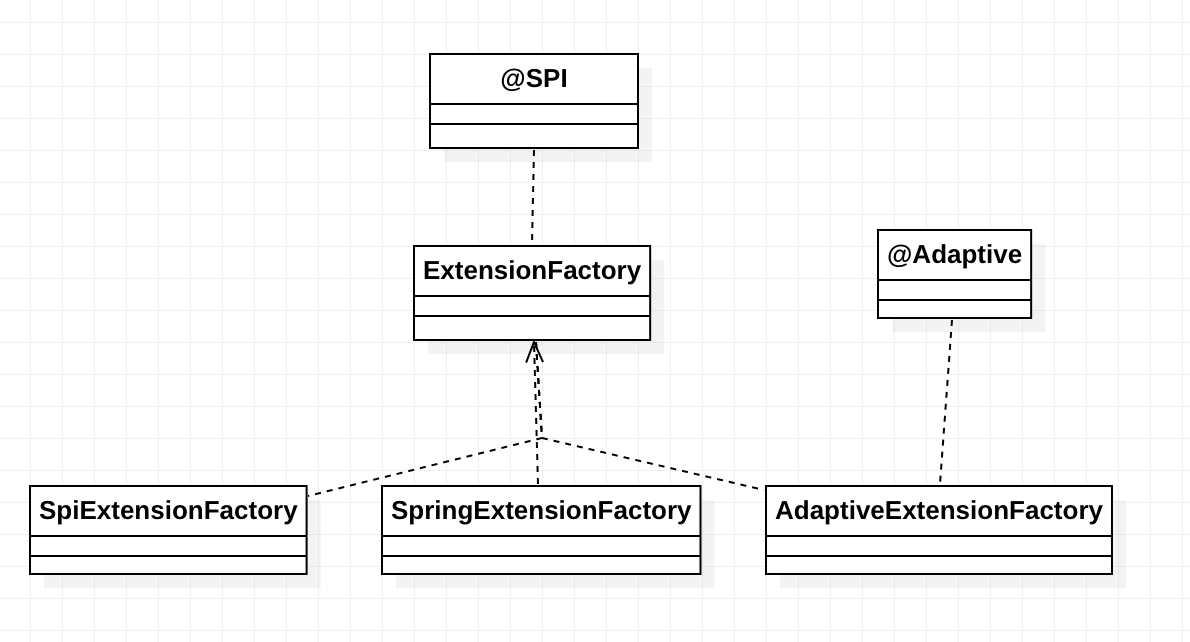该文章内容发布已经超过一年,请注意检查文章中内容是否过时。
Dubbo可扩展机制源码解析
在Dubbo可扩展机制实战中,我们了解了Dubbo扩展机制的一些概念,初探了Dubbo中LoadBalance的实现,并自己实现了一个LoadBalance。是不是觉得Dubbo的扩展机制很不错呀,接下来,我们就深入Dubbo的源码,一睹庐山真面目。
ExtensionLoader
ExtensionLoader 是最核心的类,负责扩展点的加载和生命周期管理。我们就以这个类开始吧。 ExtensionLoader 的方法比较多,比较常用的方法有:
public static <T> ExtensionLoader<T> getExtensionLoader(Class<T> type)public T getExtension(String name)public T getAdaptiveExtension()
比较常见的用法有:
LoadBalance lb = ExtensionLoader.getExtensionLoader(LoadBalance.class).getExtension(loadbalanceName)RouterFactory routerFactory = ExtensionLoader.getExtensionLoader(RouterFactory.class).getAdaptiveExtension()
说明:在接下来展示的源码中,我会将无关的代码(比如日志,异常捕获等)去掉,方便大家阅读和理解。
- getExtensionLoader方法 这是一个静态工厂方法,入参是一个可扩展的接口,返回一个该接口的ExtensionLoader实体类。通过这个实体类,可以根据name获得具体的扩展,也可以获得一个自适应扩展。
public static <T> ExtensionLoader<T> getExtensionLoader(Class<T> type) {
// 扩展点必须是接口
if (!type.isInterface()) {
throw new IllegalArgumentException("Extension type(" + type + ") is not interface!");
}
// 必须要有@SPI注解
if (!withExtensionAnnotation(type)) {
throw new IllegalArgumentException("Extension type without @SPI Annotation!");
}
// 从缓存中根据接口获取对应的ExtensionLoader
// 每个扩展只会被加载一次
ExtensionLoader<T> loader = (ExtensionLoader<T>) EXTENSION_LOADERS.get(type);
if (loader == null) {
// 初始化扩展
EXTENSION_LOADERS.putIfAbsent(type, new ExtensionLoader<T>(type));
loader = (ExtensionLoader<T>) EXTENSION_LOADERS.get(type);
}
return loader;
}
private ExtensionLoader(Class<?> type) {
this.type = type;
objectFactory = (type == ExtensionFactory.class ? null : ExtensionLoader.getExtensionLoader(ExtensionFactory.class).getAdaptiveExtension());
}
- getExtension方法
public T getExtension(String name) {
Holder<Object> holder = cachedInstances.get(name);
if (holder == null) {
cachedInstances.putIfAbsent(name, new Holder<Object>());
holder = cachedInstances.get(name);
}
Object instance = holder.get();
// 从缓存中获取,如果不存在就创建
if (instance == null) {
synchronized (holder) {
instance = holder.get();
if (instance == null) {
instance = createExtension(name);
holder.set(instance);
}
}
}
return (T) instance;
}
getExtension 方法中做了一些判断和缓存,主要的逻辑在 createExtension 方法中。我们继续看 createExtension 方法。
private T createExtension(String name) {
// 根据扩展点名称得到扩展类,比如对于LoadBalance,根据random得到RandomLoadBalance类
Class<?> clazz = getExtensionClasses().get(name);
T instance = (T) EXTENSION_INSTANCES.get(clazz);
if (instance == null) {
// 使用反射调用nesInstance来创建扩展类的一个示例
EXTENSION_INSTANCES.putIfAbsent(clazz, (T) clazz.newInstance());
instance = (T) EXTENSION_INSTANCES.get(clazz);
}
// 对扩展类示例进行依赖注入
injectExtension(instance);
// 如果有wrapper,添加wrapper
Set<Class<?>> wrapperClasses = cachedWrapperClasses;
if (wrapperClasses != null && !wrapperClasses.isEmpty()) {
for (Class<?> wrapperClass : wrapperClasses) {
instance = injectExtension((T) wrapperClass.getConstructor(type).newInstance(instance));
}
}
return instance;
}
createExtension方法做了以下事情:
- 先根据name来得到对应的扩展类。从ClassPath下
META-INF文件夹下读取扩展点配置文件。 - 使用反射创建一个扩展类的实例
- 对扩展类实例的属性进行依赖注入,即IOC。
- 如果有wrapper,添加wrapper。即AOP。
下面我们来重点看下这4个过程
- 根据name获取对应的扩展类 先看代码:
private Map<String, Class<?>> getExtensionClasses() {
Map<String, Class<?>> classes = cachedClasses.get();
if (classes == null) {
synchronized (cachedClasses) {
classes = cachedClasses.get();
if (classes == null) {
classes = loadExtensionClasses();
cachedClasses.set(classes);
}
}
}
return classes;
}
// synchronized in getExtensionClasses
private Map<String, Class<?>> loadExtensionClasses() {
final SPI defaultAnnotation = type.getAnnotation(SPI.class);
if (defaultAnnotation != null) {
String value = defaultAnnotation.value();
if (value != null && (value = value.trim()).length() > 0) {
String[] names = NAME_SEPARATOR.split(value);
if (names.length > 1) {
throw new IllegalStateException("more than 1 default extension name on extension " + type.getName());
}
if (names.length == 1) cachedDefaultName = names[0];
}
}
Map<String, Class<?>> extensionClasses = new HashMap<String, Class<?>>();
loadFile(extensionClasses, DUBBO_INTERNAL_DIRECTORY);
loadFile(extensionClasses, DUBBO_DIRECTORY);
loadFile(extensionClasses, SERVICES_DIRECTORY);
return extensionClasses;
}
过程很简单,先从缓存中获取,如果没有,就从配置文件中加载。配置文件的路径就是之前提到的:
META-INF/dubbo/internalMETA-INF/dubboMETA-INF/services
- 使用反射创建扩展实例
这个过程很简单,使用
clazz.newInstance()来完成。创建的扩展实例的属性都是空值。 - 扩展实例自动装配 在实际的场景中,类之间都是有依赖的。扩展实例中也会引用一些依赖,比如简单的Java类,另一个Dubbo的扩展或一个Spring Bean等。依赖的情况很复杂,Dubbo的处理也相对复杂些。我们稍后会有专门的章节对其进行说明,现在,我们只需要知道,Dubbo可以正确的注入扩展点中的普通依赖,Dubbo扩展依赖或Spring依赖等。
- 扩展实例自动包装 自动包装就是要实现类似于Spring的AOP功能。Dubbo利用它在内部实现一些通用的功能,比如日志,监控等。关于扩展实例自动包装的内容,也会在后面单独讲解。
经过上面的4步,Dubbo就创建并初始化了一个扩展实例。这个实例的依赖被注入了,也根据需要被包装了。到此为止,这个扩展实例就可以被使用了。
Dubbo SPI高级用法之自动装配
自动装配的相关代码在injectExtension方法中:
private T injectExtension(T instance) {
for (Method method : instance.getClass().getMethods()) {
if (method.getName().startsWith("set")
&& method.getParameterTypes().length == 1
&& Modifier.isPublic(method.getModifiers())) {
Class<?> pt = method.getParameterTypes()[0];
String property = method.getName().length() > 3 ? method.getName().substring(3, 4).toLowerCase() + method.getName().substring(4) : "";
Object object = objectFactory.getExtension(pt, property);
if (object != null) {
method.invoke(instance, object);
}
}
}
return instance;
}
要实现对扩展实例的依赖的自动装配,首先需要知道有哪些依赖,这些依赖的类型是什么。Dubbo的方案是查找Java标准的setter方法。即方法名以set开始,只有一个参数。如果扩展类中有这样的set方法,Dubbo会对其进行依赖注入,类似于Spring的set方法注入。
但是Dubbo中的依赖注入比Spring要复杂,因为Spring注入的都是Spring bean,都是由Spring容器来管理的。而Dubbo的依赖注入中,需要注入的可能是另一个Dubbo的扩展,也可能是一个Spring Bean,或是Google guice的组件,或其他任何一个框架中的组件。Dubbo需要能够从任何一个场景中加载扩展。在injectExtension方法中,是用Object object = objectFactory.getExtension(pt, property)来实现的。objectFactory是ExtensionFactory类型的,在创建ExtensionLoader时被初始化:
private ExtensionLoader(Class<?> type) {
this.type = type;
objectFactory = (type == ExtensionFactory.class ? null : ExtensionLoader.getExtensionLoader(ExtensionFactory.class).getAdaptiveExtension());
}
objectFacory本身也是一个扩展,通过ExtensionLoader.getExtensionLoader(ExtensionFactory.class).getAdaptiveExtension()来获取。

ExtensionFactory 有三个实现:
- SpiExtensionFactory:Dubbo自己的Spi去加载Extension
- SpringExtensionFactory:从Spring容器中去加载Extension
- AdaptiveExtensionFactory: 自适应的AdaptiveExtensionLoader
这里要注意 AdaptiveExtensionFactory,源码如下:
@Adaptive
public class AdaptiveExtensionFactory implements ExtensionFactory {
private final List<ExtensionFactory> factories;
public AdaptiveExtensionFactory() {
ExtensionLoader<ExtensionFactory> loader = ExtensionLoader.getExtensionLoader(ExtensionFactory.class);
List<ExtensionFactory> list = new ArrayList<ExtensionFactory>();
for (String name : loader.getSupportedExtensions()) {
list.add(loader.getExtension(name));
}
factories = Collections.unmodifiableList(list);
}
public <T> T getExtension(Class<T> type, String name) {
for (ExtensionFactory factory : factories) {
T extension = factory.getExtension(type, name);
if (extension != null) {
return extension;
}
}
return null;
}
}
AdaptiveExtensionLoader类有@Adaptive注解。前面提到了,Dubbo会为每一个扩展创建一个自适应实例。如果扩展类上有@Adaptive,会使用该类作为自适应类。如果没有,Dubbo会为我们创建一个。所以ExtensionLoader.getExtensionLoader(ExtensionFactory.class).getAdaptiveExtension()会返回一个AdaptiveExtensionLoader实例,作为自适应扩展实例。
AdaptiveExtensionLoader会遍历所有的ExtensionFactory实现,尝试着去加载扩展。如果找到了,返回。如果没有,在下一个ExtensionFactory中继续找。Dubbo内置了两个ExtensionFactory,分别从Dubbo自身的扩展机制和Spring容器中去寻找。由于ExtensionFactory本身也是一个扩展点,我们可以实现自己的ExtensionFactory,让Dubbo的自动装配支持我们自定义的组件。比如,我们在项目中使用了Google的guice这个 IOC 容器。我们可以实现自己的GuiceExtensionFactory,让Dubbo支持从guice容器中加载扩展。
Dubbo SPI高级用法之 AOP
在用Spring的时候,我们经常会用到AOP功能。在目标类的方法前后插入其他逻辑。比如通常使用Spring AOP来实现日志,监控和鉴权等功能。 Dubbo的扩展机制,是否也支持类似的功能呢?答案是yes。在Dubbo中,有一种特殊的类,被称为Wrapper类。通过装饰者模式,使用包装类包装原始的扩展点实例。在原始扩展点实现前后插入其他逻辑,实现AOP功能。
什么是Wrapper类
那什么样类的才是Dubbo扩展机制中的Wrapper类呢?Wrapper类是一个有复制构造函数的类,也是典型的装饰者模式。下面就是一个Wrapper类:
class A{
private A a;
public A(A a){
this.a = a;
}
}
类A有一个构造函数public A(A a),构造函数的参数是A本身。这样的类就可以成为Dubbo扩展机制中的一个Wrapper类。Dubbo中这样的Wrapper类有ProtocolFilterWrapper, ProtocolListenerWrapper等, 大家可以查看源码加深理解。
怎么配置Wrapper类
在Dubbo中Wrapper类也是一个扩展点,和其他的扩展点一样,也是在META-INF文件夹中配置的。比如前面举例的ProtocolFilterWrapper和ProtocolListenerWrapper就是在路径dubbo-rpc/dubbo-rpc-api/src/main/resources/META-INF/dubbo/internal/org.apache.dubbo.rpc.Protocol中配置的:
filter=org.apache.dubbo.rpc.protocol.ProtocolFilterWrapper
listener=org.apache.dubbo.rpc.protocol.ProtocolListenerWrapper
mock=org.apache.dubbo.rpc.support.MockProtocol
在Dubbo加载扩展配置文件时,有一段如下的代码:
try {
clazz.getConstructor(type);
Set<Class<?>> wrappers = cachedWrapperClasses;
if (wrappers == null) {
cachedWrapperClasses = new ConcurrentHashSet<Class<?>>();
wrappers = cachedWrapperClasses;
}
wrappers.add(clazz);
} catch (NoSuchMethodException e) {}
这段代码的意思是,如果扩展类有复制构造函数,就把该类存起来,供以后使用。有复制构造函数的类就是Wrapper类。通过clazz.getConstructor(type)来获取参数是扩展点接口的构造函数。注意构造函数的参数类型是扩展点接口,而不是扩展类。
以Protocol为例。配置文件dubbo-rpc/dubbo-rpc-api/src/main/resources/META-INF/dubbo/internal/org.apache.dubbo.rpc.Protocol中定义了filter=org.apache.dubbo.rpc.protocol.ProtocolFilterWrapper。
ProtocolFilterWrapper代码如下:
public class ProtocolFilterWrapper implements Protocol {
private final Protocol protocol;
// 有一个参数是Protocol的复制构造函数
public ProtocolFilterWrapper(Protocol protocol) {
if (protocol == null) {
throw new IllegalArgumentException("protocol == null");
}
this.protocol = protocol;
}
}
ProtocolFilterWrapper有一个构造函数public ProtocolFilterWrapper(Protocol protocol),参数是扩展点Protocol,所以它是一个Dubbo扩展机制中的Wrapper类。ExtensionLoader会把它缓存起来,供以后创建Extension实例的时候,使用这些包装类依次包装原始扩展点。
扩展点自适应
前面讲到过,Dubbo需要在运行时根据方法参数来决定该使用哪个扩展,所以有了扩展点自适应实例。其实是一个扩展点的代理,将扩展的选择从Dubbo启动时,延迟到RPC调用时。Dubbo中每一个扩展点都有一个自适应类,如果没有显式提供,Dubbo会自动为我们创建一个,默认使用Javaassist。 先来看下创建自适应扩展类的代码:
public T getAdaptiveExtension() {
Object instance = cachedAdaptiveInstance.get();
if (instance == null) {
synchronized (cachedAdaptiveInstance) {
instance = cachedAdaptiveInstance.get();
if (instance == null) {
instance = createAdaptiveExtension();
cachedAdaptiveInstance.set(instance);
}
}
}
return (T) instance;
}
继续看createAdaptiveExtension方法
private T createAdaptiveExtension() {
return injectExtension((T) getAdaptiveExtensionClass().newInstance());
}
继续看getAdaptiveExtensionClass方法
private Class<?> getAdaptiveExtensionClass() {
getExtensionClasses();
if (cachedAdaptiveClass != null) {
return cachedAdaptiveClass;
}
return cachedAdaptiveClass = createAdaptiveExtensionClass();
}
继续看createAdaptiveExtensionClass方法,绕了一大圈,终于来到了具体的实现了。看这个createAdaptiveExtensionClass方法,它首先会生成自适应类的Java源码,然后再将源码编译成Java的字节码,加载到JVM中。
private Class<?> createAdaptiveExtensionClass() {
String code = createAdaptiveExtensionClassCode();
ClassLoader classLoader = findClassLoader();
org.apache.dubbo.common.compiler.Compiler compiler = ExtensionLoader.getExtensionLoader(org.apache.dubbo.common.compiler.Compiler.class).getAdaptiveExtension();
return compiler.compile(code, classLoader);
}
Compiler的代码,默认实现是javassist。
@SPI("javassist")
public interface Compiler {
Class<?> compile(String code, ClassLoader classLoader);
}
createAdaptiveExtensionClassCode()方法中使用一个StringBuilder来构建自适应类的Java源码。方法实现比较长,这里就不贴代码了。这种生成字节码的方式也挺有意思的,先生成Java源代码,然后编译,加载到jvm中。通过这种方式,可以更好的控制生成的Java类。而且这样也不用care各个字节码生成框架的api等。因为xxx.java文件是Java通用的,也是我们最熟悉的。只是代码的可读性不强,需要一点一点构建xx.java的内容。 下面是使用createAdaptiveExtensionClassCode方法为Protocol创建的自适应类的Java代码范例:
package org.apache.dubbo.rpc;
import org.apache.dubbo.common.extension.ExtensionLoader;
public class Protocol$Adaptive implements org.apache.dubbo.rpc.Protocol {
public void destroy() {
throw new UnsupportedOperationException("method public abstract void org.apache.dubbo.rpc.Protocol.destroy() of interface org.apache.dubbo.rpc.Protocol is not adaptive method!");
}
public int getDefaultPort() {
throw new UnsupportedOperationException("method public abstract int org.apache.dubbo.rpc.Protocol.getDefaultPort() of interface org.apache.dubbo.rpc.Protocol is not adaptive method!");
}
public org.apache.dubbo.rpc.Exporter export(org.apache.dubbo.rpc.Invoker arg0) throws org.apache.dubbo.rpc.RpcException {
if (arg0 == null) throw new IllegalArgumentException("org.apache.dubbo.rpc.Invoker argument == null");
if (arg0.getUrl() == null)
throw new IllegalArgumentException("org.apache.dubbo.rpc.Invoker argument getUrl() == null");
org.apache.dubbo.common.URL url = arg0.getUrl();
String extName = (url.getProtocol() == null ? "dubbo" : url.getProtocol());
if (extName == null)
throw new IllegalStateException("Fail to get extension(org.apache.dubbo.rpc.Protocol) name from url(" + url.toString() + ") use keys([protocol])");
org.apache.dubbo.rpc.Protocol extension = (org.apache.dubbo.rpc.Protocol) ExtensionLoader.getExtensionLoader(org.apache.dubbo.rpc.Protocol.class).getExtension(extName);
return extension.export(arg0);
}
public org.apache.dubbo.rpc.Invoker refer(java.lang.Class arg0, org.apache.dubbo.common.URL arg1) throws org.apache.dubbo.rpc.RpcException {
if (arg1 == null) throw new IllegalArgumentException("url == null");
org.apache.dubbo.common.URL url = arg1;
String extName = (url.getProtocol() == null ? "dubbo" : url.getProtocol());
if (extName == null)
throw new IllegalStateException("Fail to get extension(org.apache.dubbo.rpc.Protocol) name from url(" + url.toString() + ") use keys([protocol])");
org.apache.dubbo.rpc.Protocol extension = (org.apache.dubbo.rpc.Protocol) ExtensionLoader.getExtensionLoader(org.apache.dubbo.rpc.Protocol.class).getExtension(extName);
return extension.refer(arg0, arg1);
}
}
大致的逻辑和开始说的一样,通过url解析出参数,解析的逻辑由@Adaptive的value参数控制,然后再根据得到的扩展点名获取扩展点实现,然后进行调用。如果大家想知道具体的构建.java代码的逻辑,可以看createAdaptiveExtensionClassCode的完整实现。
在生成的 Protocol$Adaptive 中,发现getDefaultPort和destroy方法都是直接抛出异常的,这是为什么呢?来看看Protocol的源码
@SPI("dubbo")
public interface Protocol {
int getDefaultPort();
@Adaptive
<T> Exporter<T> export(Invoker<T> invoker) throws RpcException;
@Adaptive
<T> Invoker<T> refer(Class<T> type, URL url) throws RpcException;
void destroy();
}
可以看到Protocol接口中有4个方法,但只有export和refer两个方法使用了@Adaptive注解。Dubbo自动生成的自适应实例,只有@Adaptive修饰的方法才有具体的实现。所以,Protocol$Adaptive 类中,也只有export和refer这两个方法有具体的实现,其余方法都是抛出异常。